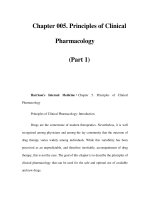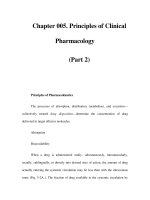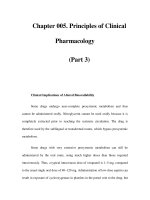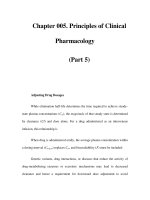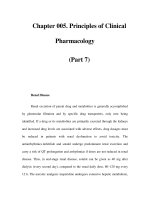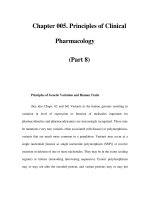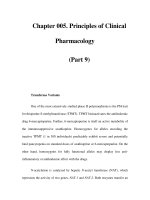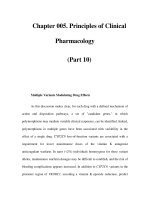Chapter 062. Principles of Human Genetics (Part 12) pptx
Bạn đang xem bản rút gọn của tài liệu. Xem và tải ngay bản đầy đủ của tài liệu tại đây (75.46 KB, 5 trang )
Chapter 062. Principles of
Human Genetics
(Part 12)
The Genetic Map
Given the size and complexity of the human genome, initial efforts aimed
at developing genetic maps to provide orientation and to delimit where a gene of
interest may be located. A genetic map describes the order of genes and defines
the position of a gene relative to other loci on the same chromosome. It is
constructed by assessing how frequently two markers are inherited together (i.e.,
linked) by association studies. Distances of the genetic map are expressed in
recombination units, or centiMorgans (cM). One cM corresponds to a
recombination frequency of 1% between two polymorphic markers; 1 cM
corresponds to ~1 Mb of DNA (Fig. 62-3). Any polymorphic sequence variation
can be useful for mapping purposes. Examples of polymorphic markers include
variable number of tandem repeats (VNTRs), RFLPs, microsatellite repeats, and
SNPs; the latter two methods are now used predominantly because of the high
density of markers and because they are amenable to automated procedures.
The Physical Map
Cytogenetics and chromosomal banding techniques provide a relatively
low-resolution microscopic view of genetic loci. Physical maps indicate the
position of a locus or gene in absolute values. Sequence-tagged sites (STSs) are
used as a standard unit for physical mapping and serve as sequence-specific
landmarks for arranging overlapping cloned fragments in the same order as they
occur in the genome. These overlapping clones allow the characterization of
contiguous DNA sequences, commonly referred to as contigs. This approach led
to high-resolution physical maps by cloning the whole genome into overlapping
fragments and has been essential for the identification of disease-causing genes by
positional cloning.
Recent insights into the structure of the normal human genome show that
certain blocks of DNA sequences, often containing numerous genes, can be
duplicated one or several times. This copy number variation (CNV), which tends
to vary in a specific manner among different populations, is associated with hot
spots of chromosomal rearrangements and is thought to play an important role in
normal human variation and in genetic disease.
The identification of the ~10 million SNPs estimated to occur in the human
genome has generated a catalogue of common genetic variants that occur in
human beings from distinct ethnic backgrounds (Fig. 62-7). SNPs that are in close
proximity are inherited together, i.e., they are linked, and are referred to as
haplotypes, hence the name HapMap (Fig. 62-8). The HapMap describes the
nature and location of these SNP haplotypes and how they are distributed among
individuals within and among populations. The HapMap information is greatly
facilitating genome-wide association studies designed to elucidate the complex
interactions among multiple genes and lifestyle factors in multifactorial disorders
(see below). Moreover, haplotype analyses may become useful to assess variations
in responses to medications (pharmacogenomics) and environmental factors, as
well as the prediction of disease predisposition.
Figure 62-7
Chromosome 7 is shown with the density of single nucleotide
polymorphisms (SNPs) and genes above. A 200-kb region in 7q31.2 containing
the CFTR gene is shown below. The CFTR gene contains 27 exons. More than
1420 mutations in this gene have been found in patients with cystic fibrosis. A 20-
kb region encompassing exons 4–9 is shown in further amplified in order to
illustrate the SNPs in this region.
Figure 62-8
The origin of haplotypes is due to repeated recombination events
occurring in multiple generations. Over time, this leads to distinct haplotypes.
These haplotype blocks can often be characterized by genotyping selected Tag
single nucleotide polymorphisms, an approach that now facilitates performing
genome-wide association studies.
